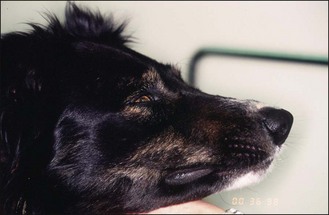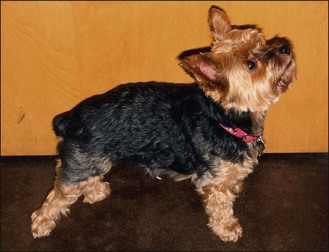63 Tetanus
CLINICAL EXAMINATION
Clinical signs typically commence 3–18 days after inoculation. Mild generalized tetanus commonly presents as a stiff gait and a rigid stance often described as a ‘saw horse’ posture. The tail may be erect or elevated. Skeletal muscle of the head is generally affected at the same time or soon after, and trismus (‘lockjaw’), retracted lips, erect ears, enophthalmos and protrusion of the third eyelid are easily noticed (Fig. 63.1). Flickering of the third eyelid is produced by intermittent spasm of the retractor bulbi muscles which creates momentary enophthalmos and a passive protrusion of the third eyelid. Laryngeal spasm, dysphagia, constipation and urine retention are possible.
Focal tetanus presents as rigidity in the inoculated limb (Fig. 63.2). It may remain localized to that limb or spread to the contralateral limb and then to the CNS. Focal tetanus is more common in cats than dogs. Recognition of signs is difficult in the slowly progressive generalized form presenting as stiffness.
Examination of this case detected a stiff gait, ears retracted higher on head, bilateral exophthalmos and less flaccid lips than expected for a spaniel. The tongue was prominent between the mandibles ventrally. There was harsh panting. The temperature was 40.3°C. She could open her mouth and could blink. There were no myotonic dimples. The gait did not improve with exercise. Strength and proprioception were normal. Muscle tone was increased in all limbs.
Stay updated, free articles. Join our Telegram channel

Full access? Get Clinical Tree




